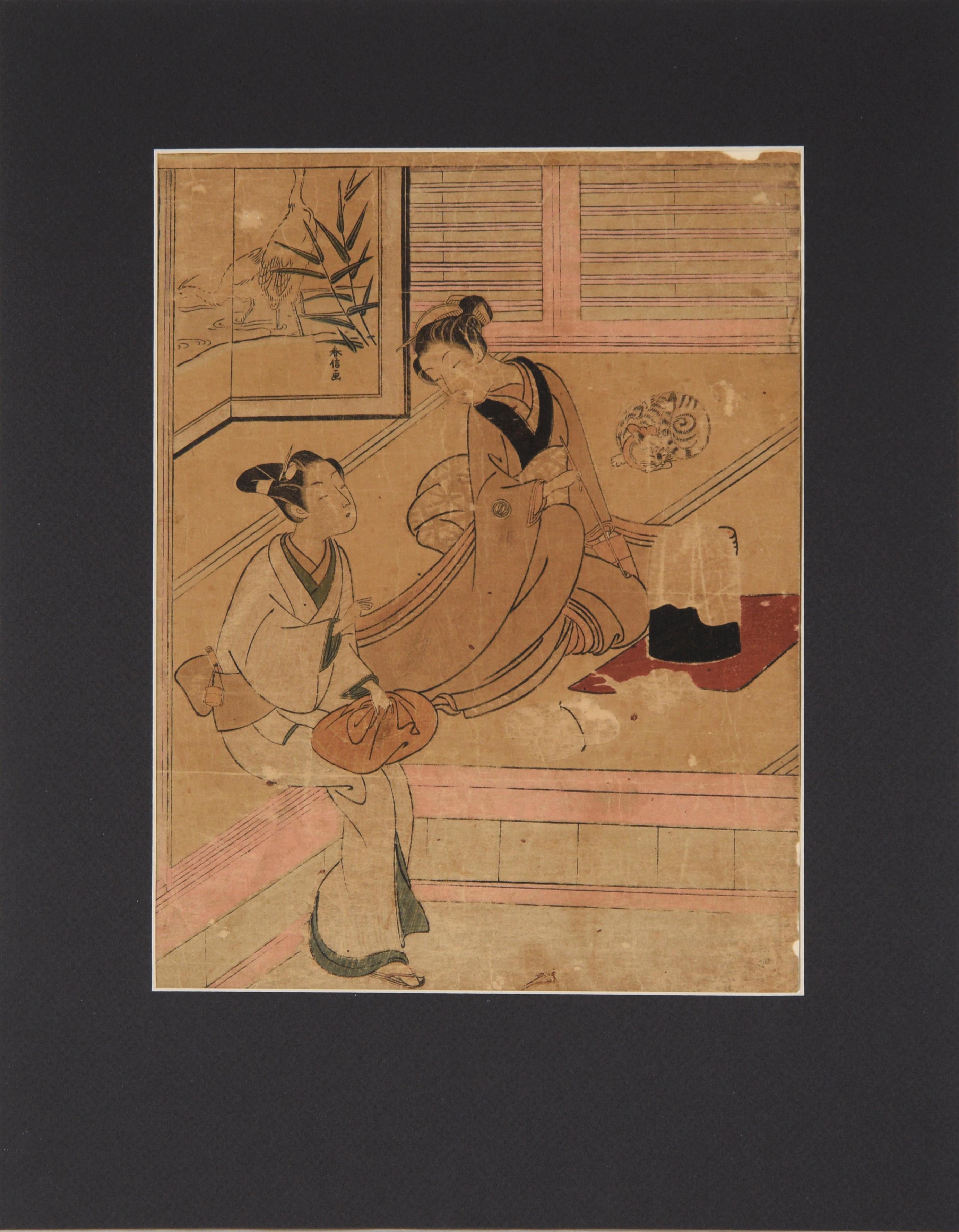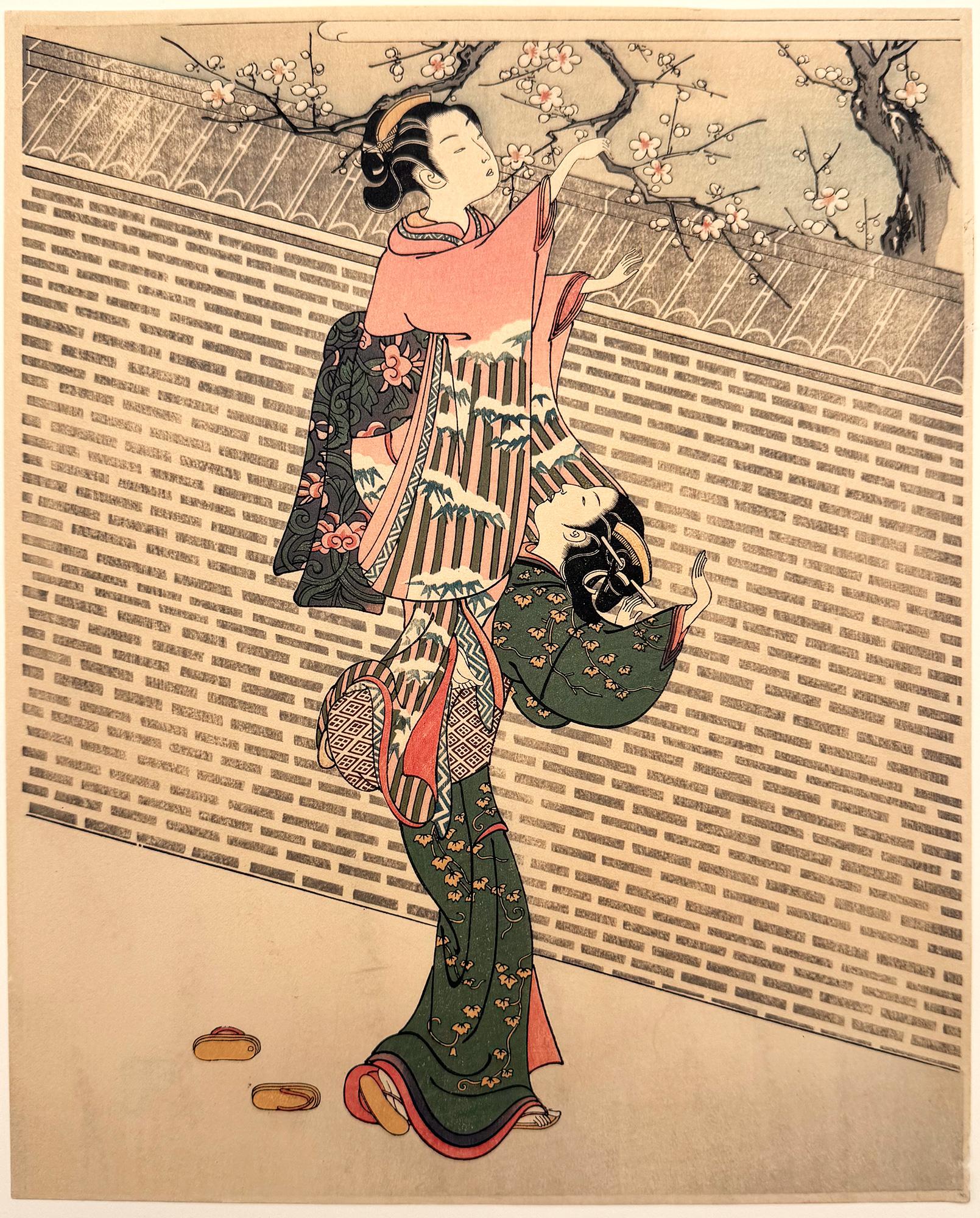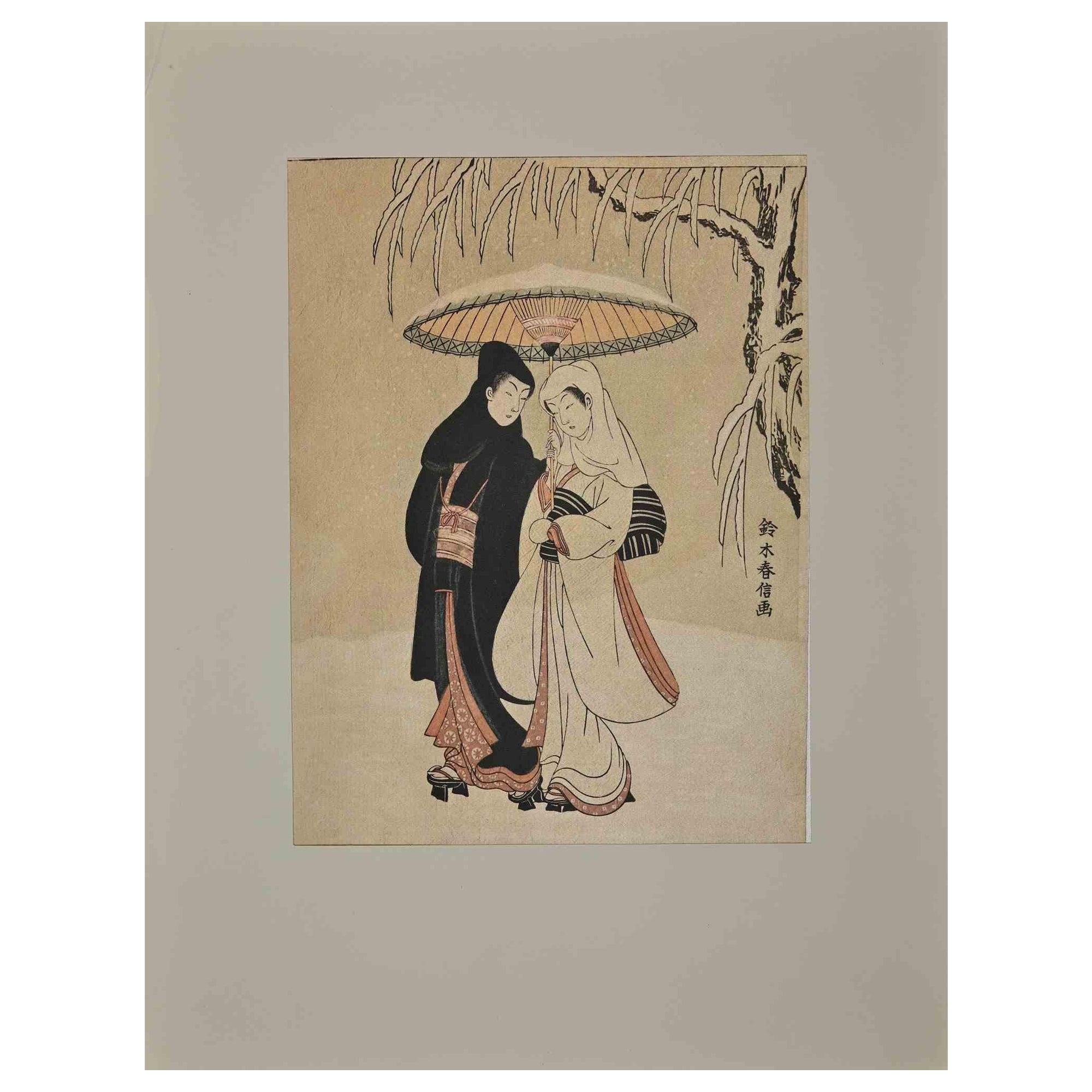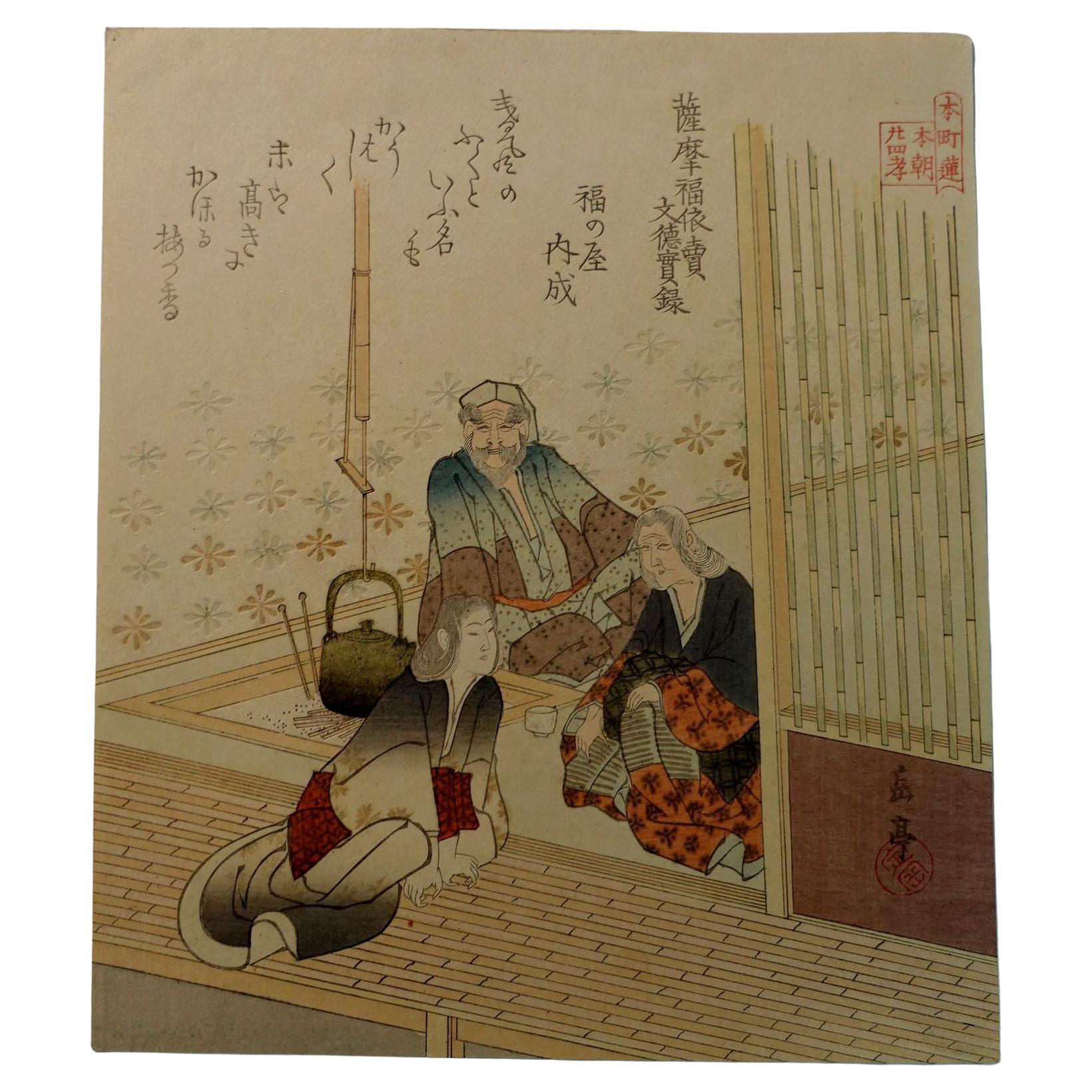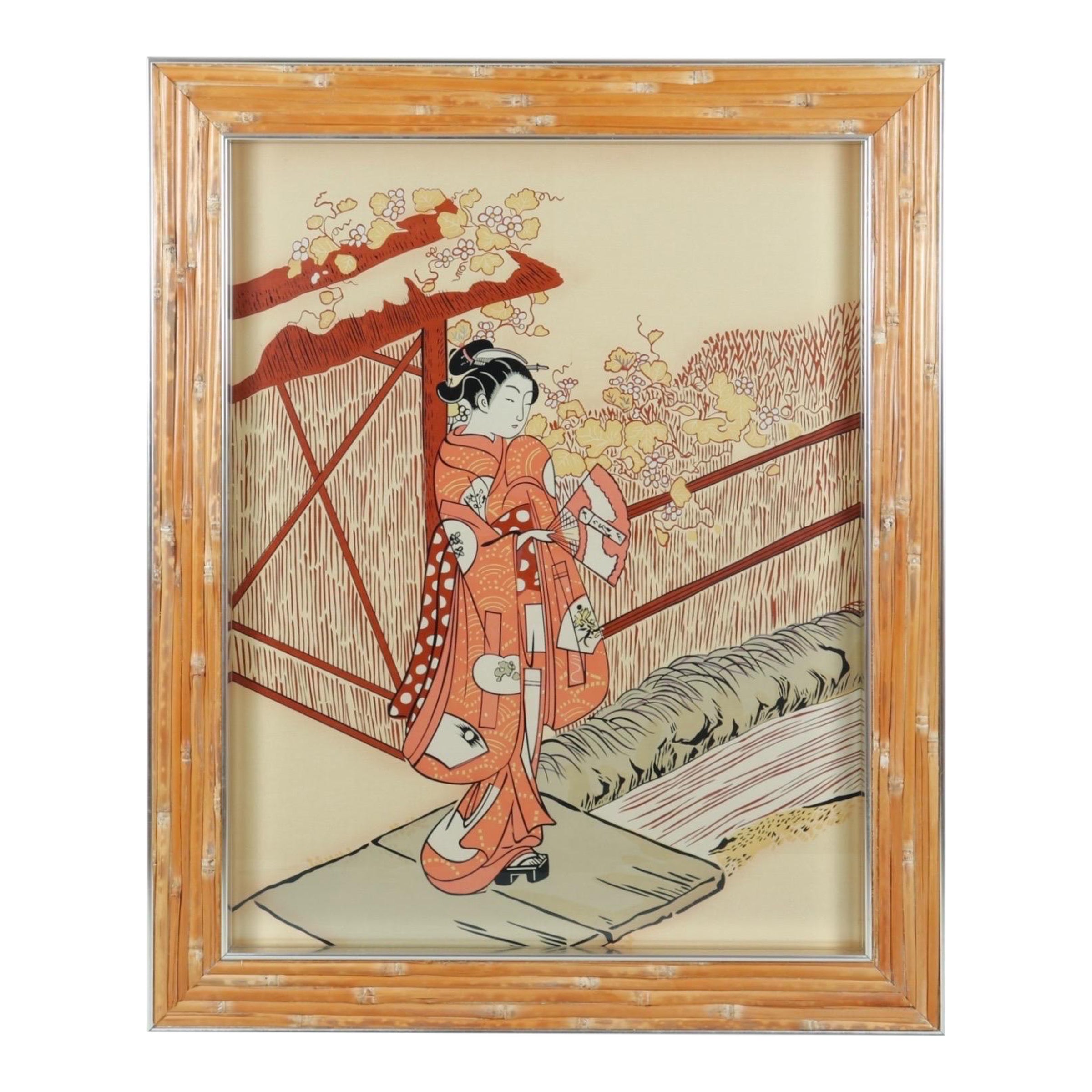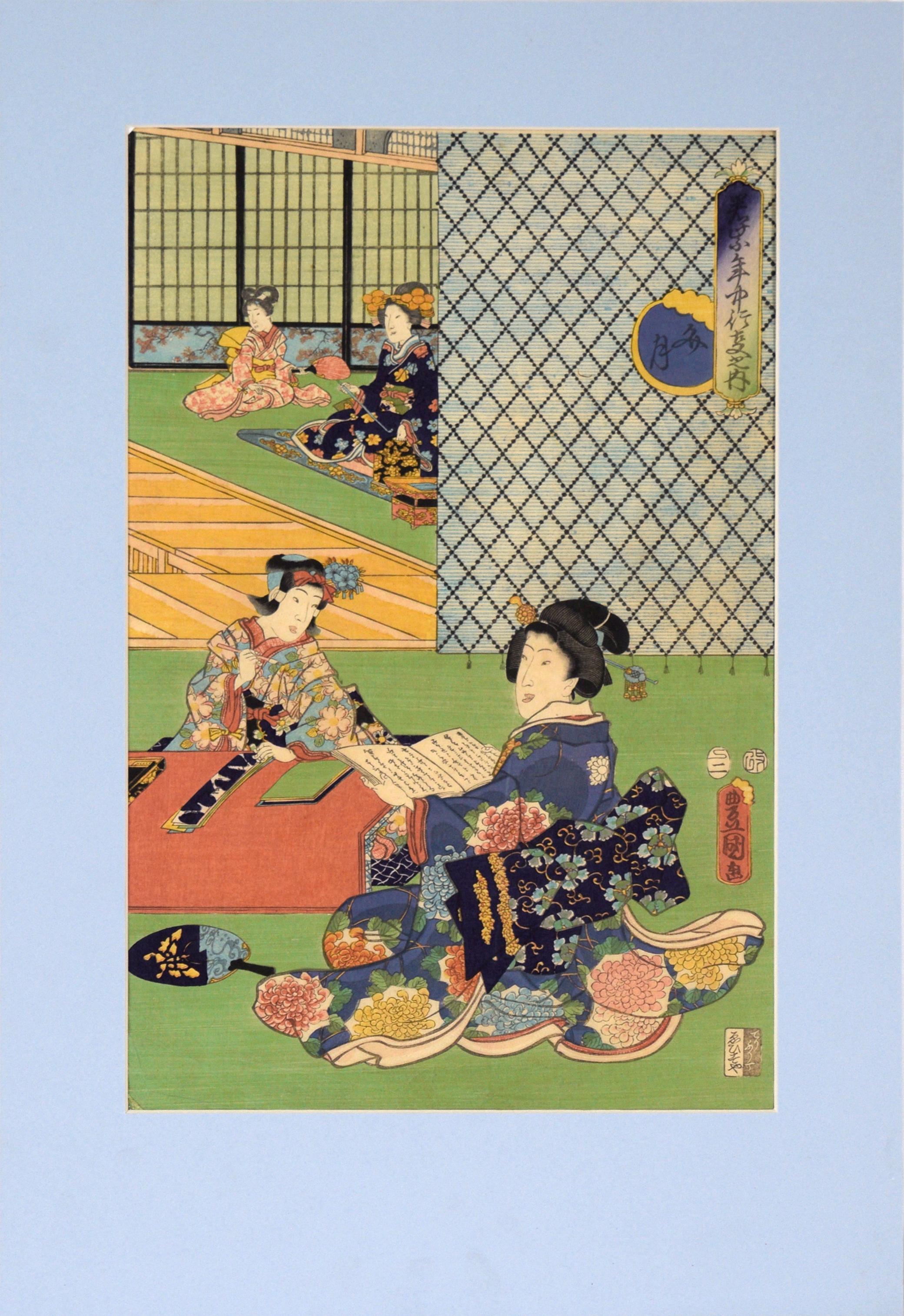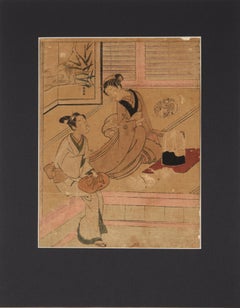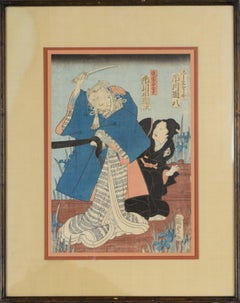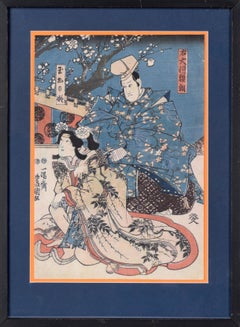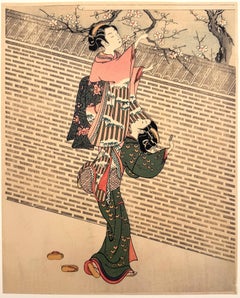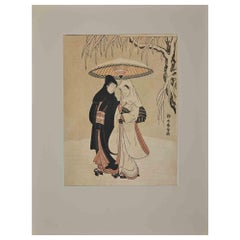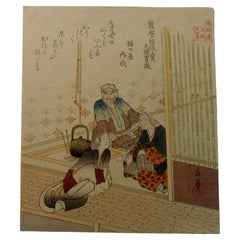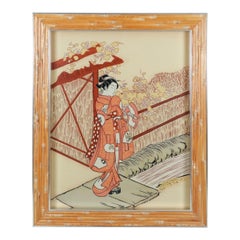Items Similar to Deutzia Flowers: The Wife of Kasamori - Original Woodblock Print
Want more images or videos?
Request additional images or videos from the seller
1 of 10
Suzuki HarunobuDeutzia Flowers: The Wife of Kasamori - Original Woodblock Print1769
1769
$900
£679.75
€785.59
CA$1,262.39
A$1,403.90
CHF 734.88
MX$17,125.84
NOK 9,233.98
SEK 8,685.75
DKK 5,863.91
About the Item
Deutzia Flowers: The Wife of Kasamori - Original Woodblock Print
Deutzia Flowers: The Wife of Kasamori, from the Series "Beauties of the Floating World Associated with Flowers" by Suzuki Harunobu
(c. 1768–1769).
Suzuki Harunobu is a ukiyo-e artist who was active at the beginning of the nishiki-e period. The beautiful women of the streets of Edo were taken as the theme of his nishiki-e art, and the works of Harunobu that stimulated interest in this genre gained popularity. “Deutzia Flowers: The Young Woman of Kasamori” is a series that likened the existing beauty of young women to flowers. It features “Unohana,” features Osen, the poster girl the “Kagiya” teahouse in Kasamori Inari Shrine in Yanaka. Standing in front of a Shutorii (a traditional Shinto shrine gate colored red) representing the Kasamori Inari Shrine, at a teahouse with a furnace and chagama (tea kettle) that serves tea, is Osen, a slender beauty wearing a Kosode robe with a crest of ivy and holding a tray. On a garden bench sits a billet doux received by Osen. Sharing popularity with Osen is Ofuji of the Yōjiya “Motoyanagiya” in Sensōji Temple in Asakusa. In this series, the nishiki-e artwork “Violet” (collection of museum), depicting two beautiful Meiwa era women.
Presented in a giltwood frame.
Frame: 18"H x 14"W
Image: 10.75"H x 8"W
Suzuki Harunobu thus became one of the primary producers of images of bijinga (pictures of beautiful women) and kabuki actors of Edo, and of similar and related subjects for the Edo print connoisseur market. In a few special cases, notably his famous set of eight prints entitled Zashiki hakkei (Eight Parlor Views), the patron's name appears on the print along with, or in place of, Harunobu's own. The presence of a patron's name or seal, and especially the omission of that of the artist, was another novel development in ukiyo-e of this time.
Between 1765 and 1770, Harunobu created over twenty illustrated books and over one thousand color prints, along with a number of paintings. He came to be regarded as the master of ukiyo-e during these last years of his life, and was widely imitated until, a number of years after his death, his style was eclipsed by that of new artists, including Katsukawa Shunshō and Torii Kiyonaga.
In addition to the revolutionary innovations that came with the introduction of nishiki-e, Harunobu's personal style was unique in a number of other respects. His figures are all very thin and light; some critics say that all his figures look like children. However, it is these same young girls who epitomize Harunobu's personal style. Richard Lane describes this as "Harunobu's special province, one in which he surpassed all other Japanese artists - eternal girlhood in unusual and poetic settings". Though his compositions, like most ukiyo-e prints, may be said to be fairly simple overall, it is the overall composition that concerned Harunobu. Unlike many of his predecessors, he did not seek to have the girls' kimono dominate the viewer's attention.
- Creator:Suzuki Harunobu
- Creation Year:1769
- Dimensions:Height: 18 in (45.72 cm)Width: 14 in (35.56 cm)Depth: 0.5 in (1.27 cm)
- Medium:
- Movement & Style:
- Period:1760-1769
- Condition:Some age toning to paper.
- Gallery Location:Soquel, CA
- Reference Number:Seller: N92091stDibs: LU54214368232
About the Seller
5.0
Platinum Seller
Premium sellers with a 4.7+ rating and 24-hour response times
Established in 1986
1stDibs seller since 2014
2,984 sales on 1stDibs
Typical response time: <1 hour
- ShippingRetrieving quote...Shipping from: Soquel, CA
- Return Policy
Authenticity Guarantee
In the unlikely event there’s an issue with an item’s authenticity, contact us within 1 year for a full refund. DetailsMoney-Back Guarantee
If your item is not as described, is damaged in transit, or does not arrive, contact us within 7 days for a full refund. Details24-Hour Cancellation
You have a 24-hour grace period in which to reconsider your purchase, with no questions asked.Vetted Professional Sellers
Our world-class sellers must adhere to strict standards for service and quality, maintaining the integrity of our listings.Price-Match Guarantee
If you find that a seller listed the same item for a lower price elsewhere, we’ll match it.Trusted Global Delivery
Our best-in-class carrier network provides specialized shipping options worldwide, including custom delivery.More From This Seller
View AllJapanese Original Woodblock Print
Located in Soquel, CA
Japanese Original Woodblock Print
Harunobu Suzuki (né Hozumi) (Japanese, 1724 - 1770)
Presented in a black mat.
Mat: 16"H x 12"W
Paper: 12"H x 9"W
I...
Category
18th Century Edo Figurative Prints
Materials
Ink, Rice Paper, Woodcut
$507 Sale Price
35% Off
Annual Events for Young Murasaki (July) - Tales of Genji - Japanese Woodblock
By Utagawa Kunisada (Toyokuni III)
Located in Soquel, CA
Annual Events for Young Murasaki (July) - Tales of Genji - Japanese Woodblock
Rightmost panel a triptych, depicting monthly events for Wakamurasaki (Young Murasaki). This is the month of July. There appears to be a lesson taking place, possibly for writing or poetry.
Artist: Toyokuni III/Kunisada (1786 - 1864)
Publisher: Ebisu-ya Shoshichist
Presented in a new blue mat.
Mat size: 19"H x 13"W
Paper size: 14.5"H x 10"W
Commentary on the triptych:
In the Edo period, Tanabata was designated as one of the five seasonal festivals, and became an annual event for the imperial court, aristocrats, and samurai families, and gradually came to be celebrated by the general public. Its origins are said to be a combination of the Kikoden festival, which originated from the Chinese legend of Altair and the Weaver Girl, and Japan's ancient Tanabata women's faith. Ink is ground with dew that has accumulated on potato leaves, poems and wishes are written on five colored strips of paper, which are then hung on bamboo branches to celebrate the two stars that meet once a year. Although the illustration is a Genji painting...
Category
1850s Realist Figurative Prints
Materials
Printer's Ink, Rice Paper, Woodcut
Kabuki Actor in Blue Kimono - Original Woodblock Print
Located in Soquel, CA
Kabuki Actor in Blue Kimono - Original Woodblock Print
Original woodblock print depicting a Kabuki actor in a blue kimono by Suzuki Harunobu (Japanese, 1725-1770). The actor holds u...
Category
1760s Edo Figurative Prints
Materials
Ink, Rice Paper, Woodcut
Two Actors - Japanese Woodblock by Chikanobu Yoshu
By Toyohara Chikanobu
Located in Soquel, CA
Two Actors - Japanese Woodblock by Toyohara Chikanobu (豊原周延, 1838–1912), better known to his contemporaries as Yōshū Chikanobu (楊洲周延).
Colorful and expressive court scene. Two actors...
Category
1890s Edo Landscape Prints
Materials
Ink, Rice Paper, Woodcut
"Various Himochi" Wagashi Festival Japanese Woodblock Print by Utagawa Toyokuni
By Utagawa Toyokuni
Located in Soquel, CA
"Various Himochi" Wagashi Festival Japanese Woodblock Print by Utagawa Toyokuni
Rare oversized early 19th century 5-tiered woodblock by Utagawa Ichiyosai Toyokuni, (Japan, 1769-1825), a Japanese lord and wife oversee a sekku festival of food, music, and dolls or toys. '"oshi" is the first day of “Mi (Snake)” in the third month of the lunar calendar. This day, known in modern Japan as the Girls' Festival, originated in China as a form of purification ceremony in which water and drinking peach blossom wine were used to drive away evil. Many kinds of hishi-mochi appear in this picture of hina ningyo (dolls associated with Hinamatsuri, or the Girl’s Day) from Omochae.
The custom of eating special dishes at events throughout the year and at milestones in people's lives has existed since ancient times. This paragraph specifically focuses on the annual event called sekku, and life events that involve eating sweets. Joshi is the first day of “Mi (Snake)” in the third month of the lunar calendar. This day, known in modern Japan as the Girls' Festival, originated in China as a form of purification ceremony in which water and drinking peach blossom wine were used to drive away evil. According to the Keiso saijiki, in ancient China, on the third day of the third lunar month, people ate “ryuzetsuhan,” which is the juice of gogyo (Jersey cudweed) mixed with rice flour and nectar. In Japan, there is a record in the Heian period history book Nihon Montoku tenno jitsuroku [839-5] that it was an annual event to make kusamochi using gogyo on the third day of the third month of the lunar calendar, which may have been influenced by Chinese customs.
The tradition of eating kusamochi on the third day of the third month of the lunar calendar continued after that. By the Edo period, however, hishimochi had come to be used as a sweet to serve on the third day of the third month. A picture of a hishimochi is included in the Morisada manko , which we mentioned in Part 1. According to it, hishimochi in the Edo period were often three layers of green-white-green instead of the now common red-white-green. However, it is possible to see from our collection that not all hishimochi were made in this way. Omochae published in 1857, is a good example. Omochae is a type of ukiyoe print...
Category
1820s Edo Figurative Prints
Materials
Ink, Rice Paper, Woodcut
Kabuki Actor with Pine-Patterned Robe - Japanese Woodblock Print
By Utagawa Toyokuni
Located in Soquel, CA
Kabuki Actor with Pine-Patterned Robe - Japanese Woodblock Print
Finely detailed woodblock by Utagawa Toyokuni (Japanese, 1769-1825). A kabuki actor is standing on a wooden deck, wearing a robe with a pine-needle pattern. He is holding a sword and a staff. In the background, tree branches hang down from out of frame.
Presented in a gold colored frame with a silk mat.
Frame size: 20"H x 14.25"W
Image size: 14"H x 8.5"W
Utagawa Toyokuni (Japanese, 1769-1825) was born in Edo, the son of Kurahashi Gorobei, a carver of dolls and puppets...
Category
Early 19th Century Impressionist Figurative Prints
Materials
Ink, Rice Paper, Woodcut
You May Also Like
Plucking a Branch from a Neighbor's Plum Tree
By Suzuki (Hozumi) Harunobu
Located in Middletown, NY
A mischievous tableau with sexual overtones.
Tokyo: Shuei-Sha, 1768.
Woodblock print in colors printed on laid mulberry paper, 10 3/4 x 7 7/8 inches (273 x 200 mm), full margins. I...
Category
Mid-18th Century Edo Portrait Prints
Materials
Handmade Paper, Watercolor, Woodcut
Lovers - Woodcut after Suzuki Harunobu - Mid-20th Century
Located in Roma, IT
Lovers Walking in the Snow is a woodcut print realized in the mid-20th Century after a woodcut print by Suzuki Harunobu.
Good conditions.
The artwork is depicted through soft line...
Category
Mid-20th Century Modern Figurative Prints
Materials
Woodcut
Japanese Woodblock Gakutei by Harunobu Sugawara-2
Located in Norton, MA
Japanese Woodblock Gakutei (1786-1868) by Harunobu Sugawara, original and unframed.
About the artist
Born in Edo as Harunobu Sugawara, Gakutei Yashima studied printmaking under Shuei and Hokkei. He moved to Osaka in the 1830s, where he designed landscape studies of his new home with a delicate and decorative style likely influenced by Hokusai. In addition to printmaking, he wrote Kyoka (comic poems), often illustrating these verses in his prints. While a talented woodblock artist, Gakutei was also known throughout Japan as a writer. He translated and illustrated the 16th-century Chinese novel Journey to the West...
Category
Antique Early 19th Century Japanese Prints
Materials
Paper
Suzuki Harunobu Framed Woodblock Print “Meeting Her Lover”
Located in Bradenton, FL
Suzuki Harunobu woodblock print titled “Meeting her Lover” (parody of the Yugao chapter of "Tale of Genji"), c. 1766. Produced by Academy Arts and copyrighted 1977. Set in a bamboo i...
Category
Vintage 1970s American Prints
Materials
Metal
The Flowering Daigo - Woodcut by Toyohara Chikanobu - 1885
By Toyohara Chikanobu
Located in Roma, IT
The Flowering Daigo is an original artwork realized in 1885 by Toyohara Chikanobu (1838–1912).
Limited edition woodcut print signed on plate.
From the series "Setsu gekka", (Snow, ...
Category
1880s Modern Figurative Prints
Materials
Woodcut
Woman - Woodcut by Utagawa Kunisada - 1830 ca.
By Utagawa Kunisada (Toyokuni III)
Located in Roma, IT
Japanese Woman is a beautiful print realized around 1830 by Utagawa Kunisada.
Original colored woodblock print.
This wonderful modern artwork represents a portrait of a Japan woman...
Category
1830s Modern Figurative Prints
Materials
Woodcut
More Ways To Browse
Thousand Flowers
Kimono Print
Antique Furnaces
Childrens Bench
Furnace Flowers
Antique Red Bench
Antique Parlor Set
Japanese Garden Bench
Shinto Shrine
Flower Painting On Rice Paper
Japanese Shinto Shrine
Torii Gate
Japanese Torii Gate
Antique Childrens Bench
Lane Bench
Antique Japanese Garden Gate
Harunobu Suzuki
Rice Tray
